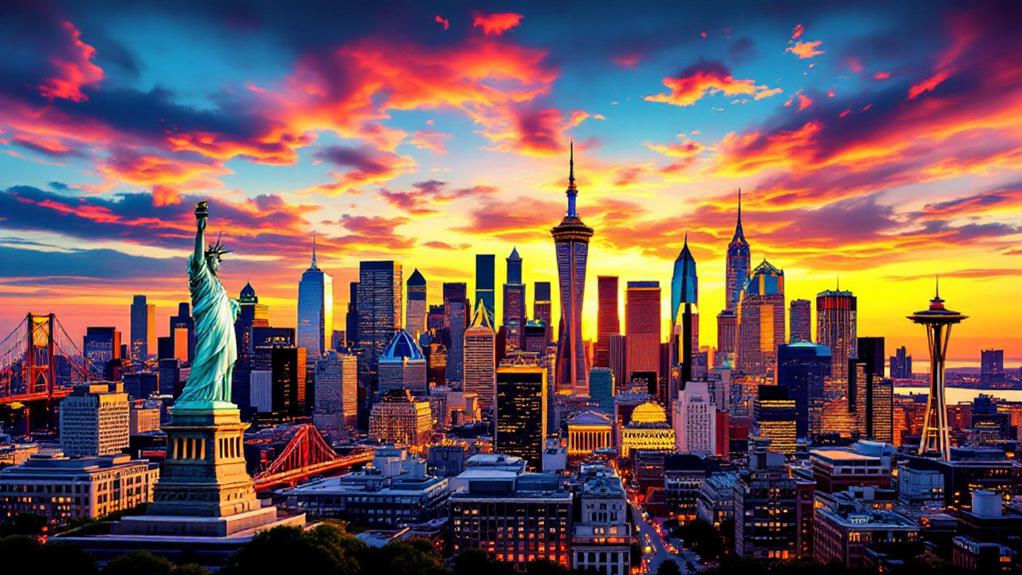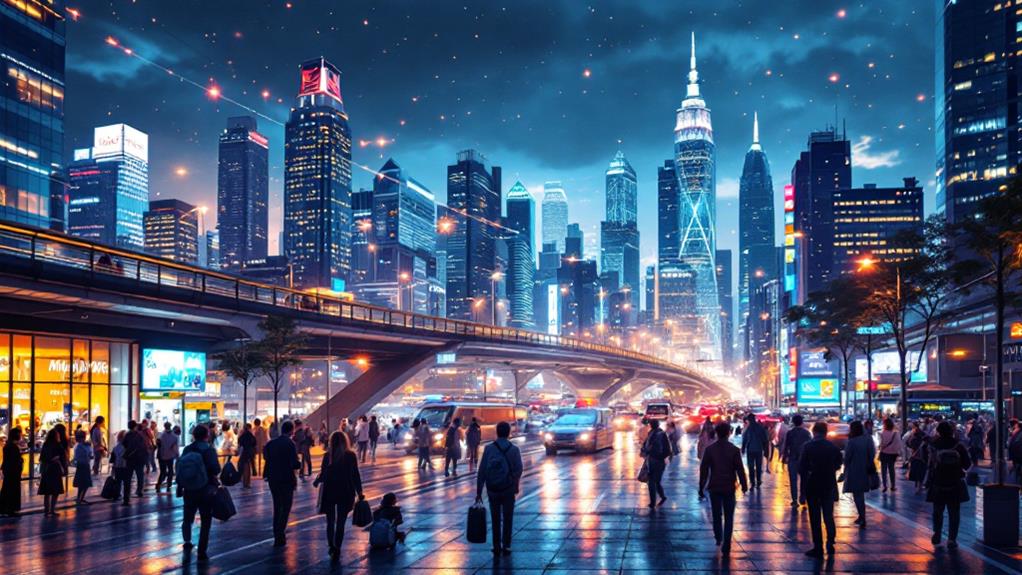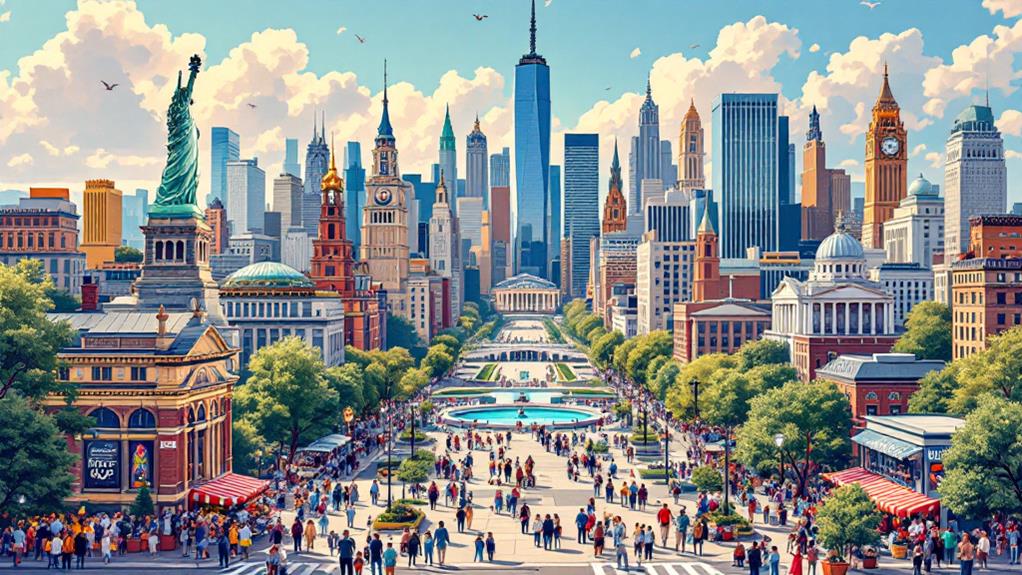Largest Cities in the U.S.: A Comprehensive List and Fun Facts

You'll find that exploring the largest U.S. cities reveals a fascinating mix of dynamic cultures and economic opportunities. New York City tops the list with its lively streets and iconic attractions like Times Square. Los Angeles, famous for Hollywood, follows with its colorful entertainment industry. Chicago enchants with its stunning architecture and deep-dish pizza. Meanwhile, Houston's thriving oil sector and Philadelphia's historical landmarks make them standout metropolises. Each city's unique charm extends to population shifts and housing trends, reflecting broader urbanization patterns. Uncover how these cities' cultural and economic landscapes shape America by delving into their enchanting stories.
Top 15 U.S. Cities
When exploring the top 15 U.S. cities, you'll frequently hear about their unique characteristics and significant contributions to the nation. Starting with New York City, you'll uncover it's the largest city in the U.S., boasting a population of about 8.34 million, according to the United States Census Bureau. Known for its cultural diversity, you'll find iconic attractions like Times Square and Central Park here. Los Angeles follows as the second-largest city, with an estimated population of 3.82 million. It's a hub for the entertainment industry, particularly Hollywood, drawing countless visitors each year.
Next, you'll encounter Chicago, the third largest city, with a population of approximately 2.67 million. It's famous for its striking architecture and delectable deep-dish pizza. Moving on, Houston ranks fourth, with around 2.3 million residents. This city is a significant player in the oil and gas industry. Ultimately, Philadelphia, the fifth largest city, holds a population of about 1.57 million and is steeped in historical significance, home to landmarks like Independence Hall. Each of these cities showcases the diverse cultural and industrial tapestry that defines America's urban landscape.
Population Dynamics
While exploring the largest U.S. cities, it's clear that dynamic population trends are reshaping the urban landscape. New York City still holds the title as the largest city in the United States, with a population of about 8.34 million, but it faces a notable decline. Between 2020 and 2021, it lost around 305,465 residents. In contrast, cities like Phoenix and San Antonio are booming, experiencing population growth rates of approximately 2.61% and 4.23%, respectively, during the same period.
The trend indicates a shift from high-cost, colder urban centers to more affordable and warmer regions. Southern cities in the United States, such as Fort Worth, TX, have seen impressive growth, with a 6.48% increase over the past decade. People are increasingly drawn to areas where the median household income can stretch further, allowing for a better quality of life.
This movement not only changes the demographics but also affects the infrastructure and social dynamics of these growing cities. As you consider the comprehensive landscape, it's fascinating to see how population growth is creating lively new hubs in the United States while other cities face challenges in retaining their residents.
Economic Highlights

Often, the economic significance of the largest U.S. cities shapes their unique identities and draws people seeking opportunity. New York City, as the largest by population with over 8.5 million residents, showcases its economic highlights through a diverse economy. With a median household income of $76,607, it stands as a guiding light for finance, fashion, and media industries. The city's vibrancy and economic strength make it a magnet for ambitious individuals.
In Los Angeles, the entertainment industry plays a crucial role in its economic highlights. Nearly 4 million people call this cultural hub home, and its median household income of $76,244 reflects the opportunities in film, television, and music. The city's allure isn't just in its sunny skies but its potential for creative and economic ventures.
Houston, with its population of approximately 2.3 million, leans heavily on the oil and gas sector. This industry's influence is evident in its median household income of $56,019. Philadelphia's rich history supports a diverse economy, particularly in healthcare, with a population of about 1.6 million and a median income of $52,649. Meanwhile, San Diego thrives on tourism and military presence, boasting a median income of $89,457 for its 1.4 million residents.
Housing Trends
Maneuvering the housing market in the largest U.S. cities can feel like an intimidating task, given the stark differences in home values and rental rates. For example, New York's median home value sits at an eye-watering $732,100, while San Antonio offers a more budget-friendly option at $167,700. Understanding these differences is essential when considering the cost of living in diverse urban areas, as housing prices greatly impact your budget.
You'll find that:
- High-Cost Cities: Los Angeles and New York are known for their soaring housing prices, with Los Angeles hitting a median home price of $822,600. These cities' economic growth often results in affordability challenges.
- Affordable Big Cities: Despite the general high costs in major cities, places like San Antonio offer more affordable housing options, with rental rates around $1,800 per month, compared to $2,210 in Chicago.
- Emerging Markets: Phoenix's housing market is on the rise with a median home value of $352,600, driven by population growth and increased demand.
Navigating these trends can help you make informed decisions about where to live, balancing the allure of big-city life with the reality of housing expenses.
Cultural Attractions

Cultural attractions play an essential role in defining the character and allure of the largest U.S. cities. When you think of New York City, its lively culture immediately comes to mind. The city dazzles with landmarks like Times Square's bright lights, the natural beauty of Central Park, and the world-class art exhibitions at the Metropolitan Museum of Art. Each year, millions are drawn to these iconic sites, experiencing the city's unique blend of history and modernity.
In San Francisco, you'll find cultural experiences that are just as enchanting. The Golden Gate Bridge stands as a symbol of engineering brilliance, while Alcatraz Island offers a glimpse into a storied past. Don't miss the colorful and lively atmospheres of Chinatown and the Mission District, where diverse cultures seamlessly mix, offering a feast for the senses.
Philadelphia, steeped in history, invites you to investigate its foundational roots. Here, Independence Hall and the Liberty Bell are more than mere attractions; they're symbols of the nation's birth. Walking through Philadelphia, you sense the echoes of history in every corner, making it a cultural gem that's impossible to ignore.
Urbanization Trends
As you investigate the lively cultural landscapes of America's largest cities, another significant aspect comes into focus: urbanization trends shaping these urban areas. Urbanization in the U.S. has resulted in notable population growth in cities, though not uniformly. While iconic metropolises like New York and Los Angeles see population declines, cities such as Phoenix and San Antonio are thriving, experiencing positive growth trends. This shift reflects broader migration patterns driven by economic opportunities and more affordable living conditions.
Consider these key urbanization trends:
- Regional Growth: The South and West are urbanizing rapidly. Texas, Florida, and Arizona lead with increased population growth due to favorable climates and dynamic job markets.
- Migration Patterns: People are moving from expensive urban centers to more affordable cities, facilitated by remote work, which offers the flexibility to prioritize living conditions without compromising career prospects.
- Pandemic Impact: COVID-19 has accelerated urbanization trends, prompting many to move to suburban areas for more space and lower costs. This shift continues to reshape city demographics.
From 2010 to 2020, all top 25 U.S. cities recorded population growth, underscoring the ongoing urbanization trend, particularly in southern cities.



